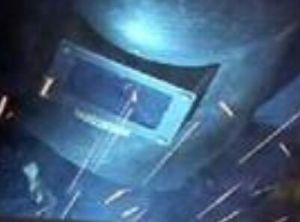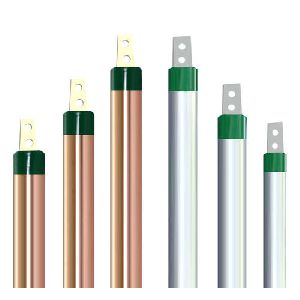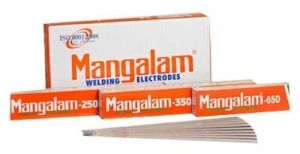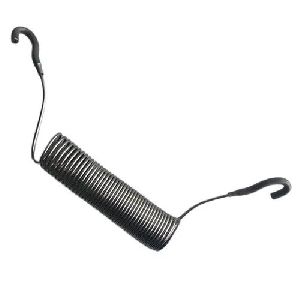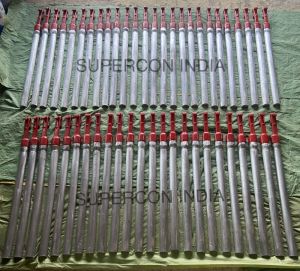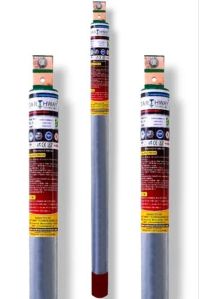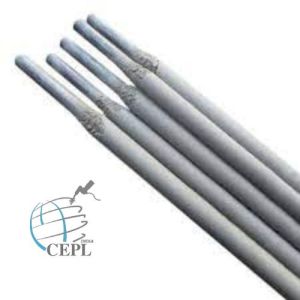Listing ID #823248
Company Information
Ask for more detail from the seller
Contact SupplierWe are offering welding electrode.
Effective maintenance and repair are essential for efficient running of industries. Welding, as a tool of maintenance and repair, plays a vitally important role in the functioning of all major industries. In general it may be said that practically and metal part which has broken or worn out in service can be reclaimed by welding. In fact, one of the first users of welding was to repair broken machinery and parts. What started out as a process for making an emergency repair until a replacement could be obtained, has today become an economic necessity to conserve expensive materials and to reduce inventories.
The need for maintenance welding arises mainly because of
• wear and
• failure
wear is caused by mechanical means like friction, abrasion and impact in case of, relative movement between the parts in contact with each other. Wear is also caused by corrosive action of the medium being handled by the particular equipment. It is observed that the magnitude of wear, may it be due to mechanical or chemical reasons, is greater at higher temperatures. Complete failure of the equipment is the next stage if wear exceeds permissible levels. Failure can also take place due to defective levels. Failure can also take place due to defective material or accidental overloads.
In addition to the application of welding process to salvage broken parts, resurfacing by welding has become an economical solution to various problems. A majority of maintenance welding is carried out by the shielded manual metal arc process.
To obtain longer service life in many cases, it is even economical to surface new parts before putting them to use.
Special features of maintenance welding
in maintenance welding, the weld metal is deposited on the wornout component or is used to join a fractured component. Therefore, it is essential that the weld metal possesses the properties which will meet the service requirements of the component and enhance its service life. Most of the times the component calls for welding only in certain areas and therefore in maintenance welding it is essential to see that the component does not lose its original properties in the areas where welding has not been done. These special features associated with maintenance welding impose restrictions on selection of welding consumables and also call on reduction of heat input during welding.
adiweld low heat input welding
adiweld low heat input welding electrodes are specially designed for low heat input welding. These electrodes are the result of extensive development, testing and analysis in our well equipped modern laboratories.
The advantages of welding, particularly for maintenance and repair applications, with low heat input welding electrodes needs no emphasis. It is well known that the composition and metallurgical state of the base material affects the properties of the deposited weld metal since the first layer will always be diluted with the base material.
The carbon content and other alloying elements can have a pronounced effect on the first layer of weld deposit. There is also a risk of damage to the desirable structure in the heat affeced zone of the base material. It is in this context that the introduction of adiweld low heat input welding electrodes can be fully appreciated. You derive the following benefits when you use lotherme electrodes :
• reduced pick-up of carbon and other detriments elements from the base material
• minimal effect on the surface of the base material adjacent to the fusion zone, known as heat affected zone.
• reduced propensity for grain coarsening in weld metal and haz, thereby resulting in better toughness of weld and haz.
• reduced width of the haz.
• reduction in the cracking tendency of the high brittle materials due to reduced 'thermal shock'.
• less distortion of the weldment.
• lower consumption of electrodes, especially in hardfacing applications due to lower dilution with the parent material.
Through developments in the design of fluxcoating, it has been ensured that each adiweld low heat input welding electrode electrode performs at low welding currents, low arc voltage and short arc length. These factors are strictly controlled to ensure that you get the maximum advantage of low heat input welding with adiweld low heat input welding electrodes.
Selection of electrode for maintenance welding
selection of electrode in maintenance welding is a very important step for achieving the desired results. The two major factors which basically control the selection of electrodes are:
• type of base material.
• service condition.
Though there are other factors which can influence the choice on welding electrodes, the above two factors primarily decide the welding electrodes.
Type of material
the different types of base materials that are normally encountered in any industry are:
• carbon and low alloy steels
• stainless steels
• austenitic mn steels and
• cast iron
the salient features of welding these materials are listed in appropriate sections in this handbook together with the electrodes that are suitable for these materials. These guidelines should help the maintenance welding personnel to select the electrode for their applications.
Welding technique
it is necessary to observe certain general procedures and precautions in order to obtain best results. Electrodes should be kept dry. Moisture pick-up affects the performance of the electrodes as also the soundness of the weld deposits. It is advisable to dry the electrodes before use as suggested in the individual product literature.
• clean the weld groove and the adjacent area thoroughly free of rust, scale, paint, oil, grease or any other surface contamination. For removal of paint, oil or grease from the surface, it is advisable to use acetone or any other solvent.
• use lowest possible current and short arc. As far as possible do not weave the electrode. Use stringer bead technique. If weaving becomes necessary due to position of welding, the width of weaving should not exceed two to three times the core wire diameter of the electrode.
• while welding on austenitic managanese steel, cast irons and thin sheets especially stainless steel, the length of each weld bead should be limited and the welds staggered over the surface to be welded. In case of austenitic managanese steel and cast irons, short and staggered weld beads help avoid cracks whereas in case of thin sheets, this technique helps control distortion.
• while welding hard and brittle materials, especially cast irons, it is necessary to peen the weld beads. Peening helps in reduction of residual stresses by 'stretching' the weld metal. Peening should be done immediately after the weld metal has solidified and the slag is removed.
• appropriate pre-heat and post-held heat treatment may have to be adopted depending upon the physical as well as the metallurgical conditions from which the parts may have to be reclaimed. Please consult our engineer for further details.
Packing and storage of electrodes
all adiweld low heat input welding electrodes are supplied in moisture-proof and shock-proof high density polythene containers. For further protection, the electrodes are first packed in moisture-proof, low density polythene bags. B & h low heat input welding electrodes are supplied in 1 kg. And 2 kg. Packing. Small quantities in each packet will help you control your inventory costs as well as avoid wastage of electrodes. H.d. Polythene containers are easy to store. No special storage conditions are necessary for adiweld low heat input welding electrodes.
The storage area, however, should not be exposed to moist conditions. Due to its economic advantages, welding naturally plays a very important role in maintenance work, particularly for emergency repairs or building-up worn out parts. There is no need to treat such work as a temporary job to keep the plant going till a replacement part is procured. Adiweld low heat input welding electrodes are specially designed to ensure that the parts reclaimed by welding, in many cases, perform better than the originals. Each adiweld low heat input welding electrode is developed after a thorough study of the application requirements.
Range
carbon and low alloy steel weld metals
• adiweld 110: low heat input electrode for welding mild steel with minimum distortion.
• adiweld 150: hydrogen controlled electrode for mild, medium carbon, high strength steels, cast steels "problem steels" and cushion layer under hard deposits.
Stainless steelweld metals
• adiweld 200: austenitic stainless steel electrode
• adiweld 210: austenitic stainless steel, acid-resistant electrode.
• adiweld 220: fully austenitic stainless steel electrode for low heat input welding aisi 309, dissimilar steels and overlays.
• adiweld 230: fully austenitic heat resistant electrode for welding of aisi 310 stainless steels and dissimilar steels.
• adiweld 250: a universal low heat input, high strength, high alloy electrode for crack free welds and overlays on steels of widely varying compositions.
Electrodes for cast iron welding
• adiweld 300: highly economical electrode for non-machinable welding of cast irons to themselves, to carbon or low alloy steels.
• adiweld 310: low heat input electrode for high strength machinable welding and overlays on grey and alloy cast iron.
• adiweld 320: low heat input ni-cu alloy type electrode for machinable welding of cast iron.
• adiweld 330: electrode for cold welding of cast iron, producing outstanding quality machinable welds on cast iron.
Hardfacing weld metals
• adiweld 400: electrode for tough and wear resistant surfacing alloy deposit.
• adiweld 410: highly wear resistant, tough surfacing electrode.
• adiweld 420: surfacing electrode with chromium carbides.
• adiweld 430: hard surfacing electrode with very high metal recovery.
• adiweld 432: surfacing electrode with exceptional hardness and abrasion resistance.
• adiweld 440: electrode for surfacing of high speed steels.
• adiweld 450: special austenitic manganese steel electrode.
• adiweld 460: extra high wear resistant, 'spray type' electrode having complex carbides. Ideally suited for reconditioning of sugar rolls.
• adiweld 470: hard surfacing electrode with controlled hydrogen, low allow steel weldmetal deposit.
• adiweld 480: corrosion and oxidation resistant, surfacing and joining electrode.
Electrodes for cutting and gauging
• adiweld 500: electrode for cutting and piercing all ferrow and non-ferrous metals and alloys without oxygen.
• adiweld 510: electrode for chamfering and grooving of various metals without oxygen.
Tin bronze electrodes
• adiweld 600: tin bronze electrode


